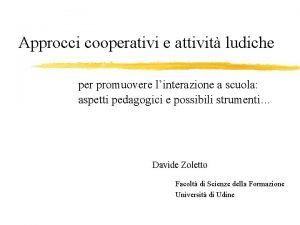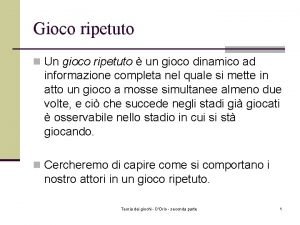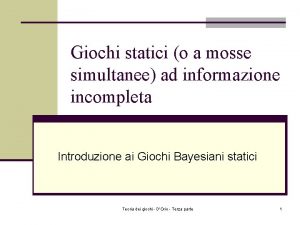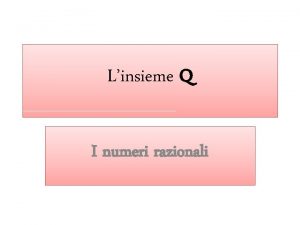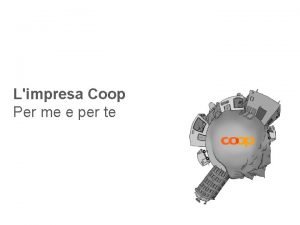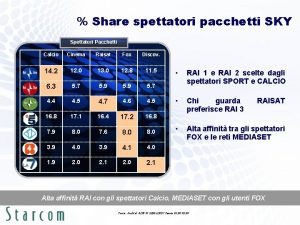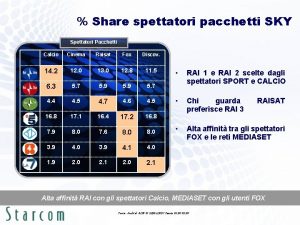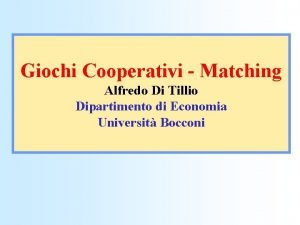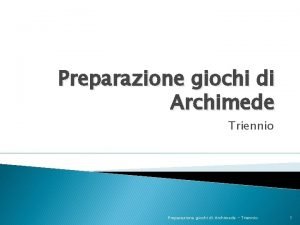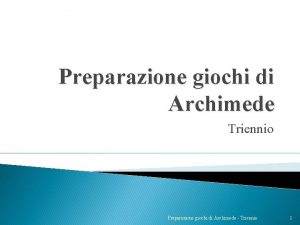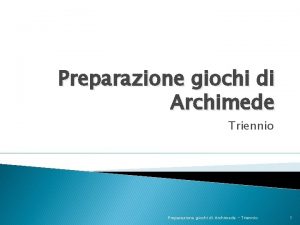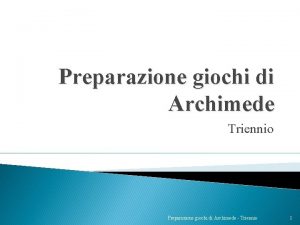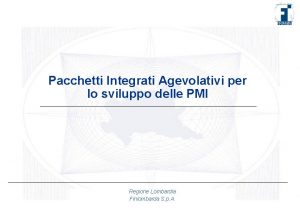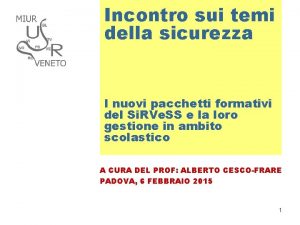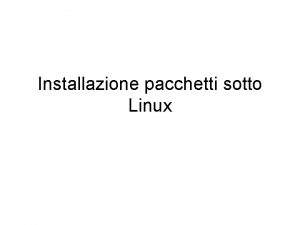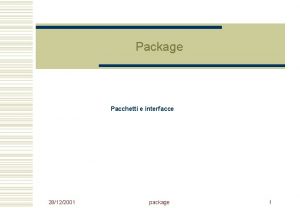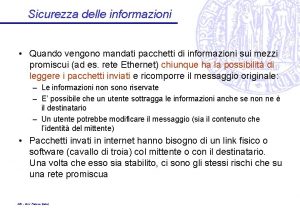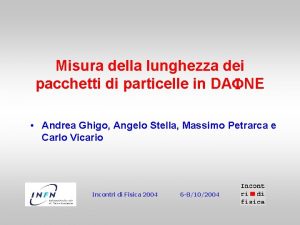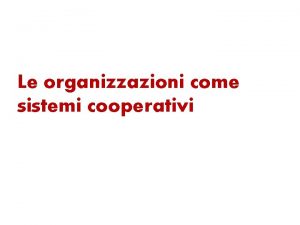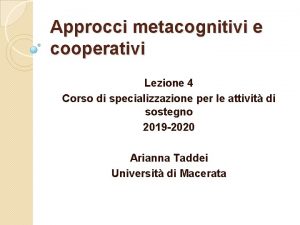Giochi non cooperativi per linstradamento di pacchetti IP






























- Slides: 30

Giochi non cooperativi per l’instradamento di pacchetti IP nella rete Internet Stefano Seccia, in collaborazione con J. -L. Rougiera, A. Pattavinab, F. Patronec, G. Maierb a Telecom Paris. Tech, France di Milano, Italy c Università di Genova, Italy b Politecnico Corso di Teoria dei Giochi, Applicazioni Collegio Borromeo, Università di Pavia, 29 -30 Marzo 2010, Pavia

Internet dissected 2 Sources: www. caida. org; the CIDR report The Autonomous Systems (ASs) number increases very fast! DEI Stefano Secci

Internet as an interconnection of ASs 3 Carrier AS Internet Exchange point ISP 1 ISP 3 AS z Multi-homed AS AS w ISP 2 Border Gateway ISP 4 AS y . . . AS u Stub AS AS number detected on a backbone BGP router routing table DEI Stefano Secci Source: The CIDR report AS x ISP 4

Intra- and Inter- Autonomous System (AS) Routing AS 1712 Address Range: 137. 194. 0. 0/16 EGP 137. 194. 50. 0 137. 194. 40. 0 137. 194. 10. 0 IGP 137. 194. 20. 0 AS 1972 Address Range: 192. 65. 10. 0/24 AS 13 Address Range: 27. 0. 0. 0/8 137. 194. 30. 0 l. An EGP protocol, i. e. , the Border Gateway Protocol (BGP) for inter-AS routing l. Many IGP protocols, e. g. , OSPF, ISIS, RIP, for intra-AS routing § BGP and IGP routing is coupled DEI Stefano Secci 4

Inter-AS business relationships: transit agreement 5 Provider A provider announces to its clients all the routes customers have full access to its network € SURE! ($$$ ) ISP national 0 ISP national D=5 D=1 00 ISP national M E D=1 0 ISP national bw ? ISP international announce me your SURE! preferences via the MED Client I’d IGP lin pre M k A fe. Cr E , gt ayno D hie uy m vne C uosue or m, Be e ISP international ISP regional DEI ISP imply infrastructure ISP Transit agreements ISP directly upgrades regional • Upgrade regional of inter-AS link capacity, routers (the customer pays for) Stefano Secci

Inter-AS business relationships: peering agreement 6 A provider announces to its peer its Peer provider network and all the routes by its clients Peer provider IGP MED mapping : Can For free! I’d prefer you use linkyou G, give OK ISP international ISP national Well Uhm. . . only if why you doshould the same I? then H, me I more bw? ISP national ISP international OK ISP national agreements do and coordination ISP not imply upgrades ISP ISP § Peering. ISP • Peering links are becoming the real bottleneck of the Internet regional regional § Peering agreements are not binding on the routing strategy DEI Stefano Secci ISP regional

Hot potato and least MED BGP rules – BGPv 4 l. Hot potato routing § If same AS hop count, § If least MED does not apply, § Choose the closer egress point. l. Least MED routing § If same AS hop count § If many ingress points to a same upstream AS, § Choose the least MED-icated route. DEI Stefano Secci 7

Rationales l. Technical 8 (BGP) § BGP routing is selfish and inefficient on peering links • Hot-potato and tie-breaking rules exclude collaborations • High bottleneck risk on peering links • Classical load sharing on peering links? Would be inefficient too § The Multi-Exit Discriminator (MED) has a collaboration nature, but is often disabled on peering links • none is customer each other’s MED-icated preferences shall be equivalent • MED usage on peering links shall be coordinated l. Game theoretic § The BGP bilateral routing solution is far from the social optimum § The MED allows exchanging routing cost information § The peering link capacity is a scarce resource • Carriers shall coordinate to avoid unstable routes and peering link congestions – while preserving their independence DEI Stefano Secci

A simple 2 -link peering game example l. AS 9 I and AS II exchange their internal routing cost via the MED §for NET A and NET B (resp. ) l. Game strategy set = possible egress links l. Table I: BGP+MED seen with a game theoretic standpoint dummy game (unilateral choices l 1, l 2 are equivalent): 4 Nash equilibria l. Table II: considering both peers’ IGP path costs (=MEDs) §NET A and NET B shall be equivalent (e. g. w. r. t. the bandwidth) Club. MED (Coordinated MED) game: 1 Nash equilibrium DEI Stefano Secci

Simple 3 -link Club. MED game examples 10 The Nash equilibrium is unique and Pareto-efficient 13 13 DEI 14 15 10 4 13 The Pareto-superior Nash equilibrium is not Pareto-efficient any longer! Stefano Secci

The Club. MED game 11 §Generalization §Mono-directional costs §Many peering links §Multiple pairs of destination communities §Congestion costs on peering links § §The resulting Club. MED game can be described as G = Gs + Gd + Gc §Gs, a selfish game (endogenous) §Gd , a dummy game, of pure externality §Gc, a congestion game (endogenous) §For m pairs and n links: permutation of m single-pair n-link Club. MED games |Xm|=|Ym|=nm DEI Stefano Secci

The Club. MED game: properties 12 §It is a potential game §The incentive to change expressed in one global potential function; §The difference in individual costs by an individual strategy move has the same value as the potential difference §Nash equilibrium Potential minimum §And a Nash equilibrium always exists §Frequent occurrence of multiple equilibria §A Club. MED Nash equilibrium is not necessarily a Pareto-efficient profile §The Pareto-frontier may not contain Nash equilibria §Gd guides the Pareto-efficiency, Gs + Gc guides the Nash equilibrium DEI Stefano Secci

Dealing with IGP Weight Optimizations (IGP-WO) • In practice, ASs may implement IGP-WO operations within their domain the IGP path cost can change after the route change • Club. MED Gs adaptation. Each peer: • Computes δ cost variations for each path w. r. t. each possible Club. MED decisions • Computes optimistic directional cost errors (ingress and egress) • Codes in the MED its two errors. • For example, egress error cost for AS I: • Broadening of the Nash set and of the Pareto-frontier • A potential threshold is arisen above the minimum • Many candidate Nash equilibria • Coordination strategies are still more necessary Tp DEI Stefano Secci 13

Club. MED-based peering link congestion controls 14 • With multiple pairs, inter-peer links congestion can be controlled with Gc • The more egress flows routed on a peering link, the more congested the link, and the higher the routing cost. • Objective: weighting the inter-carrier links when congestion may arise • A congestion cost function H: set of inter-peer flow pairs ρih the outgoing bit-rate of the flow pair h on link i Ci the egress capacity of li Gc practically not considered when DEI Stefano Secci

Nash Equilibrium Multi. Path (NEMP) routing 1. Collect the MEDs and flows’ bandwidth information 2. Compute the potential minimum 3. Compute the delta IGP path cost variations and the potential treshold 4. Compute the Nash set 5. Restrain the Nash set to the Pareto-superior equilibria When more than one, we have a multipath solution 6. The corresponding routes are the coordinated routing solution DEI Stefano Secci 15

Results for a Internet 2 – Geant 2 peering emulation • Three peering links • Traffic matrix datasets: 360 rounds (delayed of 8 hours) • By courtesy of S. Uhlig, Y. Zhang • IGP-WO run with the TOTEM toolbox (developed by UCL, ULG) xc DEI Stefano Secci 16

Results: IGP routing cost DEI Stefano Secci 17

Results: maximum link utilization DEI Stefano Secci 18

Results: Nash equilibria dynamic DEI Stefano Secci 19

Results: route stability DEI 20 Stefano Secci

21 Peering Equilibrium Multi. Path (PEMP) routing policies (cont. ) 1. Nash Equilibrium Multi. Path (NEMP) coordination • (one-shot) Play the Pareto-superior equilibria of the Nash set • Fine-selected multipath routing on peering link 2. Repeated coordination: • (repeated, high trust) Play the profiles of the Pareto-frontier • Needs a very high level of trust between peers for the long-run 3. Repeated Jump coordination: • (repeated, low trust) Unself-jump: After shrinking the Nash set w. r. t. the Pareto-efficiency, the ASs agree to make both a further step toward a choice (xj, yj) s. t. (1): ψ (xj, yj) - ψ (x 0, y 0) + φ (xj, yj) – φ (x 0, y 0) < 0 (1) • The unselfish loss that one may have is compensated by the improvement upon the other • Pareto-Jump: toward Pareto-superior profiles without unselfish unilateral loss, i. e. such that (1) and (2): ψ (xj, yj) - ψ (x 0, y 0) ≤ 0 AND φ (xj, yj) – φ (x 0, y 0) ≤ 0 (2) DEI Stefano Secci

22 Results: route stability under intra-AS congestion (PEMP) With decimated link capacities The route stability performance depends on the IGP-WO cost function DEI Stefano Secci

Results: PEMP policy trade-offs (IGP routing cost) 23 (with decimated link capacities) DEI Stefano Secci

Results: PEMP policy trade-offs (link utilization) 24 With decimated link capacities DEI Stefano Secci

But is route stability a real issue? 25 Dataset source: « A Radar for the Internet » , M. Latapy et al. DEI Stefano Secci

But is route stability a real issue? DEI Stefano Secci 26

But is route stability a real issue? (2) 27 Dataset source: « A Radar for the Internet » , M. Latapy et al. DEI Stefano Secci

Summary 28 • Very promising results. Club. MED-based NEMP strategy can: • • Avoid peering link congestion • Improve significantly the peering routing stability • Significantly decrease the bilateral routing cost Implementation aspects • Coding of multiple attributes in the MED • Refinement of the BGP decision process (at the MED step) • Ongoing work: • Extended peering coordination routing game • Resilient extension of the PEMP framework DEI Stefano Secci

Related publications 29 1. S. Secci, J. -L. Rougier, A. Pattavina, F. Patrone, G. Maier, " Peering Games for Critical Internet Flows", submitted to Euro-NF 5 th Int. Workshop on Traffic Management and Traffic Engineering for the Future Internet, 7 -8 Dec. 2009, Paris, France. 2. S. Secci, J. -L. Rougier, A. Pattavina, F. Patrone, G. Maier, "PEMP: Peering Equilibrium Multi. Path routing", in Proc. of 2009 IEEE Global Communications Conference (GLOBECOM 2009), 30 Nov. 4 Dec. 2009, Honolulu, USA. 3. S. Secci, J. -L. Rougier, A. Pattavina, F. Patrone, G. Maier, "Club. MED: Coordinated Multi-Exit Discriminator Strategies for Peering Carriers", in Proc. of 2009 5 th Euro-NGI Conference on Next Generation Internet Networks (NGI 2009), Aveiro, Portugal, 13 July 2009. Best Paper Award. DEI Stefano Secci

Contact Stefano Secci Tel. +33 1 4581 8399 secci@enst. fr Torna alla presentazione
 99 giochi cooperativi
99 giochi cooperativi Giochi per socializzare scuola primaria
Giochi per socializzare scuola primaria Giornata della terra maestra giulia
Giornata della terra maestra giulia Accoglienza scuola primaria tema olimpiadi
Accoglienza scuola primaria tema olimpiadi Equilibrio pareto efficiente teoria dei giochi
Equilibrio pareto efficiente teoria dei giochi Ottimo paretiano teoria dei giochi
Ottimo paretiano teoria dei giochi Giochi di grammatica
Giochi di grammatica Giochi della chimica soluzioni
Giochi della chimica soluzioni Giochi numerici
Giochi numerici Giochi di storia e geografia
Giochi di storia e geografia L'età del consolidamento la dinastia giulio claudia
L'età del consolidamento la dinastia giulio claudia Giochi da calcio
Giochi da calcio Giochi dieci comandamenti bambini
Giochi dieci comandamenti bambini Giochi ripetuti
Giochi ripetuti Lipogramma esempi
Lipogramma esempi Giochi statici
Giochi statici Figc sgs piemonte
Figc sgs piemonte Teoria dei giochi
Teoria dei giochi Teoria dei giochi
Teoria dei giochi Il gioco del pollo
Il gioco del pollo I giochi olimpici antichi
I giochi olimpici antichi Jclic
Jclic Je sers un sauveur tendre lyrics
Je sers un sauveur tendre lyrics Approssimazione per difetto e per eccesso
Approssimazione per difetto e per eccesso Coop per te
Coop per te Una voce il mio diletto
Una voce il mio diletto Pats joja kojos uz ausu
Pats joja kojos uz ausu 186 282 miles per second into meters per second
186 282 miles per second into meters per second S
S 600 dam/jam berapa hm/menit
600 dam/jam berapa hm/menit Per stirpes v per capita
Per stirpes v per capita
